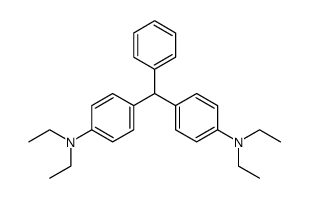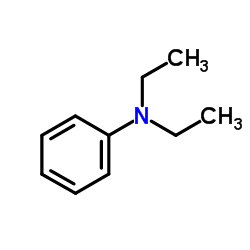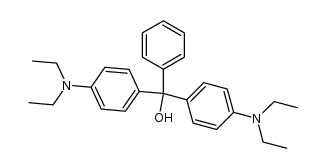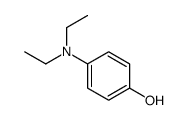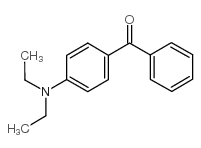633-03-4
| 中文名 | 碱性绿 1 |
|---|---|
| 英文名 | Brilliant green |
| 中文别名 |
碱性亮绿1/灿烂绿
亮绿 盐基金沙绿 碱性亮绿 灿烂绿 |
| 英文别名 |
Brilliant Green
N-(4-{[4-(Diethylamino)phenyl](phenyl)methyliden}cyclohexa-2,5-dien-1-yliden)-N-ethylethanaminiumhydrogen-_sulfat EINECS 211-190-1 4-{[4-(Diethylamino)phenyl](phenyl)methylene}-N,N-diethyl-2,5-cyclohexadien-1-iminium hydrogen sulfate Brillant green MFCD00011880 N-(4-{[4-(Diethylamino)phenyl](phenyl)methylene}-2,5-cyclohexadien-1-ylidene)-N-ethylethanaminium hydrogen sulfate Brilliant Green G EMERALD GREEN 4,4'-bis-diethylamino-tritylium,hydrogen sulfate N-(4-{[4-(diethylamino)phenyl](phenyl)methylidene}cyclohexa-2,5-dien-1-ylidene)-N-ethylethanaminium hydrogen sulfate N-(4-{[4-(Diethylamino)phenyl](phenyl)methylene}cyclohexa-2,5-dien-1-ylidene)-N-ethylethanaminium hydrogen sulfate Diamond Green G Malachite Green G |
| 描述 | 亮绿色是一种阳离子染料,用于给丝绸和羊毛上色。明亮的绿色可以抑制霉菌、肠道寄生虫和真菌的繁殖。亮绿色对革兰氏阳性菌有效[1][2]。 |
|---|---|
| 相关类别 | |
| 参考文献 |
| 熔点 | 210 °C (dec.)(lit.) |
|---|---|
| 分子式 | C27H34N2O4S |
| 分子量 | 482.635 |
| 精确质量 | 482.223938 |
| PSA | 92.29000 |
| LogP | 6.48360 |
| 外观性状 | 金属绿色晶体 |
| 储存条件 | 存放在密封容器内,并放在阴凉,干燥处。储存的地方必须远离氧化剂。 |
| 稳定性 | 远离氧化物 |
| 水溶解性 | 100 G/L (25 ºC) |
| 计算化学 | 1.疏水参数计算参考值(XlogP):无 2.氢键供体数量:1 3.氢键受体数量:5 4.可旋转化学键数量:7 5.互变异构体数量:无 6.拓扑分子极性表面积92.1 7.重原子数量:34 8.表面电荷:0 9.复杂度:642 10.同位素原子数量:0 11.确定原子立构中心数量:0 12.不确定原子立构中心数量:0 13.确定化学键立构中心数量:0 14.不确定化学键立构中心数量:0 15.共价键单元数量:2 |
| 更多 | 1. 性状:金色闪光的细结晶。 2. 密度(g/mL,25/4℃):未确定 3. 相对蒸汽密度(g/mL,空气=1):未确定 4. 熔点(ºC): 210 5. 沸点(ºC,常压):未确定 6. 沸点(ºC,5.2kPa):未确定 7. 折射率:未确定 8. 闪点(ºC):未确定 9. 比旋光度(º):未确定 10. 自燃点或引燃温度(ºC):未确定 11. 蒸气压(kPa,25ºC):未确定 12. 饱和蒸气压(kPa,60ºC):未确定 13. 燃烧热(KJ/mol):未确定 14. 临界温度(ºC):未确定 15. 临界压力(KPa):未确定 16. 油水(辛醇/水)分配系数的对数值:未确定 17. 爆炸上限(%,V/V):未确定 18. 爆炸下限(%,V/V):未确定 19. 溶解性:溶于水和乙醇呈绿色。 |
Synonym:C.I. 42040; Malachite Green G; Ethyl Green; Emerald Green; Diamond Green G; Fast Green J; Solid Gree Section 2 - COMPOSITION, INFORMATION ON INGREDIENTS
Risk Phrases: None Listed. Section 3 - HAZARDS IDENTIFICATION EMERGENCY OVERVIEW
Hygroscopic (absorbs moisture from the air). Potential Health Effects Eye: This product contains a cationic dye. Similar dyes have caused permanent injury to the cornea and conjunctiva in documented exposure cases with human or rabbit eyes. Skin: Causes skin irritation. Ingestion: May cause gastrointestinal irritation with nausea, vomiting and diarrhea. The toxicological properties of this substance have not been fully investigated. Inhalation: May cause respiratory tract irritation. The toxicological properties of this substance have not been fully investigated. Chronic: No information found. Section 4 - FIRST AID MEASURES Eyes: Immediately flush eyes with plenty of water for at least 15 minutes, occasionally lifting the upper and lower eyelids. Get medical aid immediately. SPEEDY ACTION IS CRITICAL! Skin: Get medical aid if irritation develops or persists. Wash clothing before reuse. Flush skin with plenty of soap and water. Ingestion: If victim is conscious and alert, give 2-4 cupfuls of milk or water. Never give anything by mouth to an unconscious person. Get medical aid. Inhalation: Remove from exposure and move to fresh air immediately. If not breathing, give artificial respiration. If breathing is difficult, give oxygen. Get medical aid. Notes to Physician: Section 5 - FIRE FIGHTING MEASURES General Information: As in any fire, wear a self-contained breathing apparatus in pressure-demand, MSHA/NIOSH (approved or equivalent), and full protective gear. During a fire, irritating and highly toxic gases may be generated by thermal decomposition or combustion. Vapors may be heavier than air. They can spread along the ground and collect in low or confined areas. Extinguishing Media: Use alcohol foam, carbon dioxide, or water spray when fighting fires involving this material. In case of fire, use water, dry chemical, chemical foam, or alcohol-resistant foam. Section 6 - ACCIDENTAL RELEASE MEASURES General Information: Use proper personal protective equipment as indicated in Section 8. Spills/Leaks: Clean up spills immediately, observing precautions in the Protective Equipment section. Sweep up, then place into a suitable container for disposal. Avoid generating dusty conditions. Remove all sources of ignition. Provide ventilation. Section 7 - HANDLING and STORAGE Handling: Wash thoroughly after handling. Remove contaminated clothing and wash before reuse. Use only in a well-ventilated area. Avoid contact with eyes, skin, and clothing. Keep container tightly closed. Do not ingest or inhale. Wash clothing before reuse. Storage: Store in a cool, dry, well-ventilated area away from incompatible substances. Keep containers tightly closed. Section 8 - EXPOSURE CONTROLS, PERSONAL PROTECTION Engineering Controls: Facilities storing or utilizing this material should be equipped with an eyewash facility and a safety shower. Use adequate ventilation to keep airborne concentrations low. Exposure Limits CAS# 633-03-4: Personal Protective Equipment Eyes: Wear appropriate protective eyeglasses or chemical safety goggles as described by OSHA's eye and face protection regulations in 29 CFR 1910.133 or European Standard EN166. Skin: Wear appropriate protective gloves to prevent skin exposure. Clothing: Wear appropriate protective clothing to prevent skin exposure. Respirators: A respiratory protection program that meets OSHA's 29 CFR 1910.134 and ANSI Z88.2 requirements or European Standard EN 149 must be followed whenever workplace conditions warrant respirator use. Section 9 - PHYSICAL AND CHEMICAL PROPERTIES Physical State: Solid Color: green Odor: odorless pH: Not available. Vapor Pressure: Negligible. Viscosity: Not available. Boiling Point: Not available. Freezing/Melting Point: Decomposes. Autoignition Temperature: Not applicable. Flash Point: Not applicable. Explosion Limits, lower: Not available. Explosion Limits, upper: Not available. Decomposition Temperature: 210 deg C Solubility in water: Moderately soluble in water. Specific Gravity/Density: Not available. Molecular Formula: C27H33N2.HSO4 Molecular Weight: 385.2444 Section 10 - STABILITY AND REACTIVITY Chemical Stability: Stable under normal temperatures and pressures. Conditions to Avoid: Incompatible materials, moisture. Incompatibilities with Other Materials: Strong oxidizing agents. Hazardous Decomposition Products: Nitrogen oxides, carbon monoxide, oxides of sulfur, carbon dioxide, nitrogen. Hazardous Polymerization: Will not occur. Section 11 - TOXICOLOGICAL INFORMATION RTECS#: CAS# 633-03-4: BP6825000 LD50/LC50: Not available. Carcinogenicity: Brilliant Green - Not listed by ACGIH, IARC, or NTP. Other: See actual entry in RTECS for complete information. Section 12 - ECOLOGICAL INFORMATION Other No information available. Section 13 - DISPOSAL CONSIDERATIONS Dispose of in a manner consistent with federal, state, and local regulations. Section 14 - TRANSPORT INFORMATION IATA Not regulated as a hazardous material. IMO Not regulated as a hazardous material. RID/ADR Not regulated as a hazardous material. Section 15 - REGULATORY INFORMATION European/International Regulations European Labeling in Accordance with EC Directives Hazard Symbols: Not available. Risk Phrases: Safety Phrases: S 45 In case of accident or if you feel unwell, seek medical advice immediately (show the label where possible). WGK (Water Danger/Protection) CAS# 633-03-4: 2 Canada CAS# 633-03-4 is listed on Canada's DSL List. CAS# 633-03-4 is not listed on Canada's Ingredient Disclosure List. US FEDERAL TSCA CAS# 633-03-4 is listed on the TSCA inventory. SECTION 16 - ADDITIONAL INFORMATION N/A |
|
毒理学数据: 1 、急性毒性:小鼠(腹膜)LDLo: 5mg/kg 小鼠(静脉)LDLo: 3mg/kg 大鼠(口服)LDLo:10mg/kg 大鼠(腹膜)LDLo: 8mg/kg 豚鼠(腹膜)LDLo: 3mg/kg 由于食盐的LD50是3,000 mg/kg,BPA的急性毒性程度与食盐同。 生态学数据: 对水稍微有危害的,不要让未稀释或者大量产品接触地下水,水道或者污水系统。若无政府许可,勿将材料排入周围环境。 CHEMICAL IDENTIFICATION
HEALTH HAZARD DATAACUTE TOXICITY DATA
MUTATION DATA
|
| 符号 |

GHS07 |
|---|---|
| 信号词 | Warning |
| 危害声明 | H302-H319 |
| 警示性声明 | P305 + P351 + P338 |
| 个人防护装备 | dust mask type N95 (US);Eyeshields;Faceshields;Gloves |
| 危害码 (欧洲) | Xn:Harmful; |
| 风险声明 (欧洲) | R22;R36 |
| 安全声明 (欧洲) | S26-S39 |
| 危险品运输编码 | 2811 |
| WGK德国 | 3 |
| RTECS号 | BP6825000 |
| 包装等级 | II |
| 危险类别 | 6.1(a) |
| 上游产品 5 | |
|---|---|
| 下游产品 4 | |



